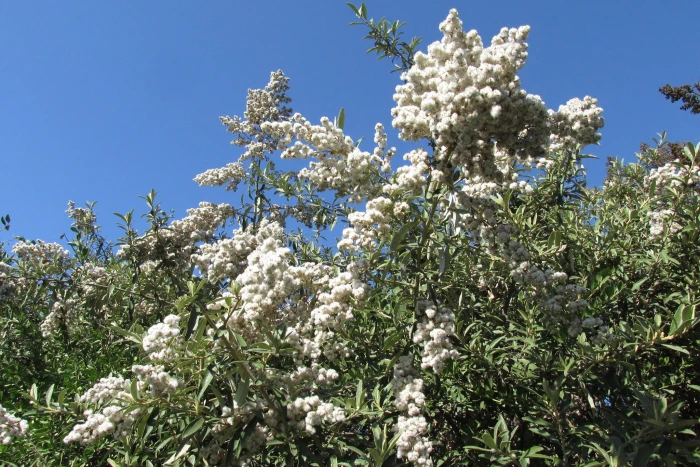Camphor Bush
(Tarchonanthus camphoratus)
Camphor Bush (Tarchonanthus camphoratus)
/
/

Caroline Voget
CC BY 4.0
Image By:
Caroline Voget
Recorded By:
Copyright:
CC BY 4.0
Copyright Notice:
Photo by: Caroline Voget | License Type: CC BY 4.0 | License URL: http://creativecommons.org/licenses/by/4.0/ | Rights Holder: Caroline Voget | Publisher: iNaturalist | Date Created: 42147 |

























Estimated Native Range
Climate Requirements for Cleveland, Tennessee
| This Plant | Your Site | Plant Suitability for Your Location | ||
|---|---|---|---|---|
| • Precipitation | 4" - 60" | 56" | Aquatic | Aquatic |
| • High Temp. | 71°F - 101°F | 90°F | Your summer temperatures are normal for this plant. | Excellent |
| • Low Temp. | 27°F - 65°F | 28°F | Your winter temperatures are normal for this plant | Excellent |
This plant may not grow well at your location - your precipitation is too high.
Summary
Tarchonanthus camphoratus, commonly known as camphor bush or leleshwa in Kenya, is a semi-deciduous shrub or small tree native to a variety of habitats including savannas, bushveld, and dry woodland areas across Africa south of the Sahel. It typically grows up to 20 feet tall and has a spread of about 10-15 feet. The plant’s twigs and younger stems are covered in a white felt-like tomentum, and it has dark olive-green leaves that emit a strong camphor scent when bruised. The camphor bush produces small, inconspicuous cream or yellow flowers that are followed by fluffy seed heads, which are wind-dispersed.
The camphor bush is valued for its aromatic leaves and its ability to thrive in dry, challenging environments, making it suitable for xeriscaping and as a windbreak in arid regions. It is also used for medicinal purposes in its native range, and the wood is sometimes utilized for carving. In cultivation, it requires full sun to part shade, well-drained soil, and is drought-tolerant once established. However, it can be potentially invasive in some parts of the world, so gardeners should check local regulations before planting.CC BY-SA 4.0
The camphor bush is valued for its aromatic leaves and its ability to thrive in dry, challenging environments, making it suitable for xeriscaping and as a windbreak in arid regions. It is also used for medicinal purposes in its native range, and the wood is sometimes utilized for carving. In cultivation, it requires full sun to part shade, well-drained soil, and is drought-tolerant once established. However, it can be potentially invasive in some parts of the world, so gardeners should check local regulations before planting.CC BY-SA 4.0
Plant Description
- Plant Type: Shrub, Tree
- Height: 6-20 feet
- Width: 6-20 feet
- Growth Rate: Moderate
- Flower Color: Cream
- Flowering Season: Fall
- Leaf Retention: Evergreen, Semi-deciduous
Growth Requirements
- Sun: Full Sun
- Water: Low
- Drainage: Medium, Fast
Common Uses
Drought Tolerant, Fragrant, Low Maintenance, Street Planting
Natural Habitat
Savannas, bushveld, and dry woodland areas
Other Names
Common Names: Camphor Bush, Leleshwa, Camphorwood, Wild Cotton
Scientific Names: Tarchonanthus camphoratus, Tarchonanthus abyssinicus, Tarchonanthus abyssinicus, Tarchonanthus camphoratus subsp. litakunensis, Tarchonanthus camphoratus var. camphoratus, Tarchonanthus camphoratus var. litakunensis, Tarchonanthus litakunensis, Tarchonanthus procerus
GBIF Accepted Name: Tarchonanthus camphoratus